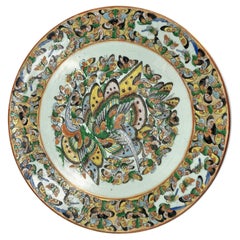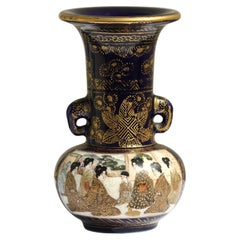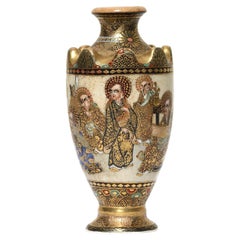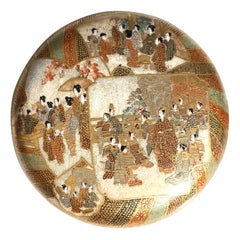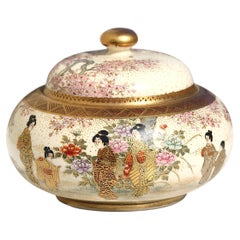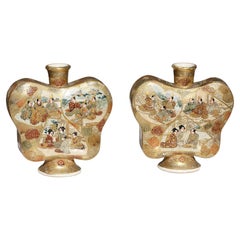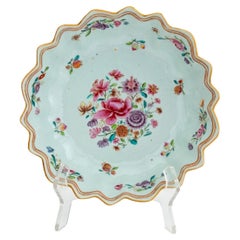A.B. Levy's Ceramics
to
1
21
21
7
14
1
1
19
4
1
1
1
21
21
21
5
1
Chinese Famille Rose Rose Medallion Porcelain Platter
Located in West Palm Beach, FL
Chinese Famille Rose Rose Medallion Porcelain Platter Late 19th/early 20th Century.The circular platter with a raised foot is decorated with allover butterflies.
Diameter 14.75 in.
...
Category
20th Century Ceramics
Materials
Ceramic
Satsuma earthenware cabinet vase
Located in West Palm Beach, FL
Satsuma earthenware cabinet vase, early 20th century, decorated with ladies and immortals, the long neck flanked by elephant handles, signed.
Height 4.62 in. (11.74 cm.), by 3 in. (...
Category
20th Century Ceramics
Materials
Ceramic
Satsuma Earthenware Cabinet Vase, Early 20th Century
By Satsuma
Located in West Palm Beach, FL
Satsuma earthenware cabinet vase, early 20th century. Decorated with immortals, signed.
Height 4.25 in. (10.79 cm.), by 2.5 in. (6.35 cm.)
Category
20th Century Ceramics
Materials
Ceramic
A Japanese Satsuma Earthenware Circular Box and Cover
By Satsuma
Located in West Palm Beach, FL
A Japanese Satsuma earthenware circular box and cover, MEIJI PERIOD (1868-1912), the interior and exterior decorated with gilt and contrasting figural scenes, signed Satsuma yaki se...
Category
20th Century Ceramics
Materials
Porcelain
A Japanese Satsuma earthenware circular box and cover
By Satsuma
Located in West Palm Beach, FL
A Japanese Satsuma earthenware circular box and cover,
19th/early 20th century
sealed with Satsuma
Category
20th Century Ceramics
Materials
Porcelain
A pair of "butterfly" Satsuma earthenware vases, Meiji period
Located in West Palm Beach, FL
A pair of "butterfly" Satsuma earthenware vases, Meiji period
finely decorated in enamels and gilt with scenes of Samurai and retainers and high ranking female members of the househ...
Category
Antique 19th Century Ceramics
Materials
Ceramic
A Cloisonné Dish Meiji period (1868-1912)
Located in West Palm Beach, FL
A Cloisonne Dish
Meiji period (1868-1912)
decorated with a lively Falcon reserved on a light pink ground
diameter 11 3/4 inches
Category
20th Century Ceramics
Materials
Ceramic
Chinese Carved Jade Figure of a Phoenix
Located in West Palm Beach, FL
A Chinese carved jade figure of a phoenix
Third quarter 20th century
Perching atop rockwork with the finely incised wings
Measures: height 5 in. ...
Category
20th Century Antiquities
Materials
Jade
Chinese Carved Pale Caledon Vase and Cover
Located in West Palm Beach, FL
A Chinese carved pale caledon vase and cover
Carved in the form of a "mythical chicken" standing erect with long plumage, front neck has a very unusual...
Category
20th Century Ceramics
Materials
Celadon
Japanese Cloisonne Enamel Vase 19th Century
Located in West Palm Beach, FL
A Japanese Cloisonne enamel vase
19th century
Measures: Height 8.5 in. (21.59 cm.),
Width 3.62 in. (9.20 cm.).
Category
Antique 19th Century Ceramics
Materials
Ceramic
Japanese Cloisonne Vase and Cover, Meiji Period
Located in West Palm Beach, FL
A Japanese Cloisonne vase and cover, Meiji period
finely decorated in silver and copper wire and a variety of coloured enamels with six panels, the body and cover with bands of lapp...
Category
20th Century Ceramics
Materials
Copper
Three Antique Japanese Works of Art
Located in West Palm Beach, FL
Three Antique Japanese Works of Art
An oribe "morikage" (for the display of seasonal fruits), classic green drip glaze with spontaneous ink pain...
Category
Antique 1890s Ceramics
Materials
Porcelain
Pair of Sevres Type Ormolu Mounted Pictorial Cache-Pots, 19th Century
Located in West Palm Beach, FL
Pair of sevres- Type ormolu mounted pictorial cache-pots, 19th century,
Measures: 7.5 inches high
6.5 diameter.
Category
20th Century Ceramics
Materials
Ceramic
Qinqbai Lobed Conical Bowl, Chinese Probably Song Dynasty
Located in West Palm Beach, FL
A Qinqbai lobed conical bowl, Chinese,
probably Song Dynasty
Measures: Height 1 in. (2.54 cm.), diameter 5.06 in. (12.85 cm.)
Category
Antique 19th Century Ceramics
Materials
Ceramic
Pair of Chinese 'blanc-de-chine' 'Buddhist Lion' Joss Stick Holders
Located in West Palm Beach, FL
A pair of Chinese 'blanc-de-chine' 'Buddhist Lion' joss stick holders
probably Qing dynasty
Each superbly modeled seated in opposing poses above re...
Category
20th Century Ceramics
Materials
Porcelain
Japanese Satsuma Style Censer and Cover, Late 19th Century
Located in West Palm Beach, FL
Japanese Satsuma style censer and cover
Late 19th century
The bulbous body supported by four feet and set with two shishi han...
Category
Antique Late 19th Century Ceramics
Materials
Ceramic
Japanese Satsuma Cylindrical Koro and Cover, Signed Gyokuzan, Meiji Period
Located in West Palm Beach, FL
A Japanese Satsuma cylindrical koro and cover, signed Gyokuzan,
Meiji period (1868-1912)
Raised on three supports, painted and gilt with a continuous scene of ladies and children p...
Category
Antique 19th Century Ceramics
Materials
Ceramic
$3,040 Sale Price
20% Off
Japanese Satsuma Earthenware Vase, Meiji Period
Located in West Palm Beach, FL
Japanese Satsuma Earthenware Vase, Meiji Period, 1868-1912, of baluster form, the decorated in poly-chrome enamels and gilt on a clear crackle glaze with a Daimyo procession, the nec...
Category
20th Century Ceramics
Materials
Ceramic
Kinkozan, Japanese Satsuma Vase, Meiji Period
By Kinkozan
Located in West Palm Beach, FL
Kinkozan, Japanese Satsuma vase,
Meiji Period (1868-1912)
Of baluster form with an elongated neck decorated in polychrome enamels and gilt on a clear crackle glaze in an Art-Nouvea...
Category
20th Century Ceramics
Materials
Ceramic
Satsuma Earthenware Vase and Cover, Japanese, Meiji Period
By Satsuma
Located in West Palm Beach, FL
A Satsuma Earthenware vase and cover,
Japanese, Meiji period, (1868-1912)
decorated in polychrome enamels and gilt over a clear, crackled glaze, delicately painted with samurai on ...
Category
Antique 1890s Antiquities
Materials
Ceramic
Satsuma Earthenware Covered Box, by Kinkozan
By Satsuma
Located in West Palm Beach, FL
A Satsuma Earthenware covered box,
by Kinkozan,
Japanese, Meiji period (1868-1912)
decorated in polychrome enamels and gilt over a clear, crackled glaze, delicately painted with s...
Category
Antique Early 1900s Ceramics
Materials
Earthenware
Related Items
Chinese Export Famille Rose Porcelain Lobed Bowl
Located in Astoria, NY
Chinese Export Famille Rose Porcelain Lobed Bowl, Qianlong Period, circa 1760, with hand-painted floral and fruit motif and label to underside. 10.25" Diameter x 2.75" H. Provenance:...
Category
Antique Mid-18th Century Chinese Chinese Export Ceramics
Materials
Porcelain
Japanese Meiji Period (1868-1912) Satsuma Earthenware Vase Taizan for Hattori
Located in Newark, England
Meiji Period (1868-1912)
From our Japanese collection, we are delighted to offer Japanese Meiji Period Satsuma Vases. The Satsuma Vase of hexagonal form with a slight waisted neck and tight rounded rim is extensively decorated with multiple figures to two large scenes. The first scene features a beach with waves to the background and a plethora of figures including multiple geisha holding traditional Japanese wagasa’s. The second scene follows on from the first with a large building in the foreground holding figures on a large platform under a pagoda roof with a pagoda building in the background and further figures in the foreground. The scenes are framed by a full detailed border with gilt shapes, flowers amongst pink shaded backgrounds and butterflies around the neck. The Satsuma Vase is unusually signed Fine Art, Satsuma Ware, Dai Nippon (Great Japan), Hattori Made, Gosuido Works, Taizan Painted. 美術, サツマヤキ(薩摩焼), 大日本, 服部造, 五スイ堂工, 對山画 and dates to the Meiji Period (1868-1912) and the turn of the 20th century circa 1905.
Satsuma ware is a type of earthenware pottery originating from the Satsuma province in Southern Kyushu, Japan’s third largest island.
Wagasa are traditional Japanese umbrellas made of washi paper attached to a bamboo frame and treated to ensure it is waterproof.
Meiji Period was an era of Japanese history that spanned from 1868 to 1912. It was the first half of the Empire of Japan, when the Japanese people began to build a paradigm of a modern, industrialised nation state and emergent great power, influenced by Western countries and aesthetics. As a result of radically different ideas, the changes to Japan were profound and it affected the social structure, politics, economy, military, and foreign relations across the board. The period corresponded to the reign of Emperor Meiji and was preceded by the Keio era and was succeeded by the Taisho era.
Cultural Art during the Meiji Period was of particular interest to the government and they overhauled the art export market which in turn promoted Japanese arts via various world’s fairs, beginning in Vienna at the world fair in 1873. The government heavily funded the fairs and took an active role organising how Japan’s culture was presented to the world including creating a semi-public company named Kiritsu Kosho Kaisha (First Industrial Manufacturing Company). The Kiritsu Kosho Kaisha was used to promote and commercialise exports of Japanese art and established the Hakurankai Jimukyoku (Exhibition Bureau) to maintain quality standards. For the 1876 Centennial International Exhibition in Philadelphia, the Japanese government created a Centennial Office and sent a special envoy to secure space for the 30,000 items that would be displayed. The Imperial Household also took an active interest in arts and crafts, commissioning works by select artists to be given as gifts for foreign dignitaries further emphasising the high quality and importance of Japanese art. Just before the end of the 19th century in 1890, the Teishitsu Gigeiin (Artist to the Imperial Household) system was created to recognise distinguished artists. These artists were selected for their exceptionally high quality wares and talent in their own industry. Over a period of 54 years Seventy artists were appointed, amongst these were ceramicist Makuzu Kozan and cloisonné enamel artist...
Category
Antique Early 1900s Japanese Meiji Ceramics
Materials
Earthenware, Pottery
$3,134
H 4.63 in W 2.17 in D 2.37 in
Large Chinese Export Famille Rose Medallion Porcelain Charger, Mid-19th Century
Located in Atlanta, GA
A richly enameled Chinese Export porcelain charger in the classic Famille Rose Medallion palette, dating to the mid-19th century, Qing Dynasty, circa 1850. This large dish exemplifie...
Category
Antique Mid-19th Century Chinese Chinese Export Ceramics
Materials
Porcelain
$950
H 0.5 in Dm 13 in
Japanese Meiji Period (1868-1912) Satsuma Vase by Kinkozan
By Kinkozan
Located in Newark, England
JAPANESE SATSUMA PROCESSIONAL VASE
From our Japanese collection, we are delighted to introduce to the market this Japanese Satsuma Vase by Kinkozan. The vase with a compressed body ...
Category
Antique Late 19th Century Japanese Meiji Ceramics
Materials
Ceramic, Earthenware, Pottery
A Fine Japanese Satsuma Vase . Meiji Period. Kinkozan
Located in London, GB
A Fine Japanese Satsuma Vase with Bijin, Peacock, and Chrysanthemums.
Attributed to Kinkozan Workshop, Kyoto, Meiji period (late 19th century)
Of pear-shaped form with a flared f...
Category
Antique 19th Century Japanese Ceramics
Materials
Ceramic, Porcelain
A Fine Japanese Satsuma vase signed by Ryokuzan. Meiji period
Located in London, GB
A exquisite Satsuma vase signed by Ryokuzan.
Meiji Era.
Of a slender ovoid shape featuring intricate hand-painted designs and delicate gilded accents.
The vase is adorned with...
Category
Antique 19th Century Japanese Ceramics
Materials
Ceramic, Porcelain
Chinese Export Famille Rose Porcelain Plate
Located in Astoria, NY
Chinese Export Famille Rose Porcelain Plate, with hand-painted central landscape scene with a peacock and flowers encircled by a scrolling floral border. 9" Diameter x 1.25" H. P...
Category
Antique Late 19th Century Chinese Qing Ceramics
Materials
Porcelain
Japanese Antique Satsuma Pottery Buddhist Monks Vase with Shimazu Crest Mark
By Satsuma
Located in Studio City, CA
A beautiful Japanese Satsuma pottery studio vase featuring multiple kesa-clad enlightened Buddhist monks on each side of the vase. The piece is finely detailed with rich raised gilt highlights throughout and beautifully decorated in gold and various hand painted other colors.
From the Meiji period (1868-1912).
This piece has the all-important Shimazu Family crest mark (red circle with a cross inside) on the base authenticating the work as an old and original Satsumaware work. The mark shows the pottery was made under the rule of the Shimazu clan.
From a Los Angeles Collection...
Category
Early 20th Century Japanese Meiji Ceramics
Materials
Earthenware, Pottery
$1,250
H 11.5 in W 4.5 in D 4.5 in
Satsuma Japanese Meiji Miniature Enameled Teapot Kozon Mark
By Satsuma
Located in Bishop's Stortford, Hertfordshire
An exceptional Japanese Satsuma miniature spool shaped pottery teapot and cover finely hand enameled with Kozon mark and dating from around 1880. This delightful teapot has an invers...
Category
Antique 19th Century Japanese Meiji Ceramics
Materials
Pottery
Thai Celadon Vase, Early 20th Century
Located in New York, NY
A hand-made ceramic vase from Thailand, Early 20th Century.
Ribbed shape, tapered neck, classic Celadon green crackle finish.
Excellent condition for its age and use.
Category
Antique Early 1900s Thai Other Vases
Materials
Celadon
A Fine Pair of Japanese Satsuma Vases, Meiji Period , Signed Reizan.
Located in London, GB
A Fine Pair of Japanese Satsuma Vases, Meiji Period , Signed Reizan.
Of baluster form with gently flared neck and footrim, each vase exquisitely hand-painted in with continuous pa...
Category
Antique 19th Century Japanese Ceramics
Materials
Ceramic, Porcelain
$1,158 / set
H 8.27 in W 3.94 in D 8.27 in
Japanese Satsuma Earthenware Four-Panel Tea Caddy, Ryuzan - Kyoto, Meiji-Taisho
Located in Atlanta, GA
Japanese Satsuma Earthenware Four-Panel Tea Caddy
Attributed to Ryuzan Studio (龍山), Kyoto, Meiji–Taisho Period, circa 1900–1920
A finely painted Japanese Satsuma earthenware tea cad...
Category
Antique Late 19th Century Japanese Aesthetic Movement Ceramics
Materials
Enamel
